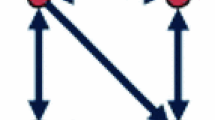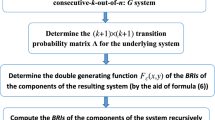Abstract
We consider the three-state toric homogeneous Markov chain model (THMC) without loops and initial parameters. At time \(T\), the size of the design matrix is \(6 \times 3\cdot 2^{T-1}\) and the convex hull of its columns is the model polytope. We study the behavior of this polytope for \(T\ge 3\) and we show that it is defined by \(24\) facets for all \(T\ge 5\). Moreover, we give a complete description of these facets. From this, we deduce that the toric ideal associated with the design matrix is generated by binomials of degree at most \(6\). Our proof is based on a result due to Sturmfels, who gave a bound on the degree of the generators of a toric ideal, provided the normality of the corresponding toric variety. In our setting, we established the normality of the toric variety associated to the THMC model by studying the geometric properties of the model polytope.

Similar content being viewed by others
References
Bruns, W., Ichim, B., Söger, C.: Normaliz, a tool for computations in affine monoids, vector configurations, lattice polytopes, and rational cones (2011)
Diaconis, P., Sturmfels, B.: Algebraic algorithms for sampling from conditional distributions. Ann. Stat. 26(1), 363–397 (1998)
Gawrilow, E., Joswig, M.: polymake: a framework for analyzing convex polytopes. In: Kalai, G., Ziegler, G.M. (eds.) Polytopes—Combinatorics and Computation, pp. 43–74. Birkhäuser, Basel (2000)
Hara, H., Takemura, A.: A markov basis for two-state toric homogeneous markov chain model without initial paramaters. J. Jpn. Stat. Soc. 41, 33–49 (2011)
Haws, D., Martin del Campo, A., Yoshida, R.: Degree bounds for a minimal markov basis for the three-state toric homogeneous markov chain model. In: Proceedings of the Second CREST-SBM International Conference, “Harmony of Grobner Bases and the Modern Industrial Society”, pp. 99–116 (2012)
Miller, E., Sturmfels, B.: Combinatorial commutative algebra. In: Graduate texts in mathematics. Springer, Berlin (2005) http://books.google.com/books?id=CqEHpxbKgv8C
Pachter, L., Sturmfels, B.: Algebraic Statistics for Computational Biology. Cambridge University Press, Cambridge (2005)
Pardoux, E.: Markov Processes and Applications: Algorithms, Networks, Genome and Finance. In: Wiley Series in Probability and Statistics Series. Wiley, Incorporated (2009)
Schrijver, A.: Theory of Linear and Integer Programming. Wiley, New York (1986)
Sturmfels, B.: Gröbner Bases and Convex Polytopes. In: University Lecture Series, vol. 8. American Mathematical Society, Providence (1996)
Takemura, A., Hara, H.: Markov chain monte carlo test of toric homogeneous markov chains. Stat. Methodol. 9, 392–406 (2012). doi:10.1016/j.stamet.2011.10.004
Author information
Authors and Affiliations
Corresponding author
Additional information
Research of Martín del Campo supported in part by NSF Grant DMS-915211.
Appendix
Appendix
The six cones used in defining \(Q^r\) for \(r=0,\ldots ,5\):
for \(r=0,\ldots ,5\).
The six polytopes used in defining \(Q^r\) for \(r=0,\ldots ,5\) are given below, where the vertices are modulo the permutations of \(S = \{1,2,3\}\). That is, the indexing below is \(x_{12}, x_{21}, x_{13}, x_{31}, x_{23}\), and \(x_{32}\). To get the full list of vertices one should use all six permutations of \(\{1,2,3\}\) and permute the indices of each vertex below accordingly.
\(\mathrm{{vert}}( Q^0) := [\) [0, 1, 1, 0, 0, 1], [0, 1, 2, 1/2, 1, 3/2], [0, 1, 3/2, 1, 1/2, 2], [0, 2, 2, 0, 1, 2], [0, 2, 2, 0, 2, 5], [0, 2, 2, 2/3, 0, 7/3], [0, 2, 3, 0, 2, 4], [0, 2, 4, 2, 0, 3], [0, 2, 3/2, 0, 0, 3/2], [0, 2, 7/3, 0, 2/3, 2], [0, 3, 4, 0, 0, 4], [0, 6/5, 8/5, 4/5, 2/5, 11/5], [0, 6/5, 11/5, 2/5, 4/5, 8/5], [2/3, 4/3, 4/3, 2/3, 2/3, 7/3]\( ]\).
\({{\mathrm{vert}}}( Q^1) := [\) [0, 0, 0, 0, 0, 0], [0, 0, 0, 1, 3, 2], [0, 0, 1, 0, 2, 3], [0, 1, 1, 0, 1, 3], [0, 1, 1, 0, 2, 2], [0, 1, 2, 0, 1, 2], [0, 1, 2, 1, 0, 2], [0, 1, 1/2, 1/2, 1/2, 1/2], [0, 1/2, 0, 1/2, 1, 1], [0, 1/2, 1, 1, 1/2, 0], [0, 1/2, 1/2, 1, 1/2, 1/2], [0, 1/2, 1/2, 1/2, 1, 1/2] \(]\).
\({{\mathrm{vert}}}( Q^2) := [\) [0, 1, 1, 0, 1, 2], [0, 1, 2, 1/2, 2, 5/2], [0, 1, 3, 3/2, 1, 3/2], [0, 1, 3/2, 1, 3/2, 3], [0, 1, 5/2, 2, 1/2, 2], [0, 2, 2, 0, 2, 5], [0, 2, 2, 0, 3, 4], [0, 2, 2, 1, 2, 4], [0, 2, 3, 0, 2, 4], [0, 2, 4, 2, 0, 3], [0, 2, 4, 2, 1, 2], [0, 3, 4, 0, 3, 7], [0, 3, 7, 3, 0, 4], [1/3, 2/3, 2/3, 1/3, 1/3, 2/3], [1/3, 2/3, 5/3, 5/6, 4/3, 7/6], [1/3, 2/3, 7/6, 4/3, 5/6, 5/3], [2/3, 4/3, 4/3, 2/3, 2/3, 7/3], [2/3, 4/3, 4/3, 2/3, 5/3, 4/3] \(]\).
\({{\mathrm{vert}}}( Q^3) := [\) [0, 0, 0, 0, 0, 0], [0, 0, 0, 1, 1, 0], [0, 1, 1, 0, 2, 4], [0, 1, 2, 0, 2, 3], [0, 1, 3, 2, 0, 2] \(]\).
\({{\mathrm{vert}}}( Q^4) := [\) [0, 1, 1, 0, 0, 1], [0, 1, 2, 1/2, 1, 3/2], [0, 1, 3/2, 1, 1/2, 2], [0, 2, 2, 0, 1, 4], [0, 2, 2, 0, 2, 3], [0, 2, 2, 1, 1, 3], [0, 2, 3, 0, 1, 3], [0, 2, 3, 1, 0, 3], [0, 2, 3, 1, 1, 2], [0, 3, 4, 0, 2, 6], [0, 3, 6, 2, 0, 4], [1/3, 5/3, 5/3, 1/3, 1/3, 8/3], [1/3, 5/3, 5/3, 1/3, 4/3, 5/3] \(]\).
\({{\mathrm{vert}}}( Q^5) := [\) [0, 0, 0, 0, 1, 1], [0, 0, 0, 1, 4, 3], [0, 0, 1, 0, 3, 4], [0, 1, 1, 0, 2, 4], [0, 1, 1, 0, 3, 3], [0, 1, 2, 0, 2, 3], [0, 1, 3, 2, 0, 2], [0, 1, 1/2, 1/2, 3/2, 3/2], [0, 1, 3/2, 3/2, 1/2, 1/2], [0, 1/2, 0, 1/2, 2, 2], [0, 1/2, 2, 2, 1/2, 0], [0, 1/2, 1/2, 1/2, 2, 3/2], [0, 1/2, 3/2, 2, 1/2, 1/2], [1, 2, 1/2, 1/2, 1/2, 1/2] \(]\).
Rights and permissions
About this article
Cite this article
Haws, D., Martín del Campo, A., Takemura, A. et al. Markov degree of the three-state toric homogeneous Markov chain model. Beitr Algebra Geom 55, 161–188 (2014). https://doi.org/10.1007/s13366-013-0178-y
Received:
Accepted:
Published:
Issue Date:
DOI: https://doi.org/10.1007/s13366-013-0178-y




